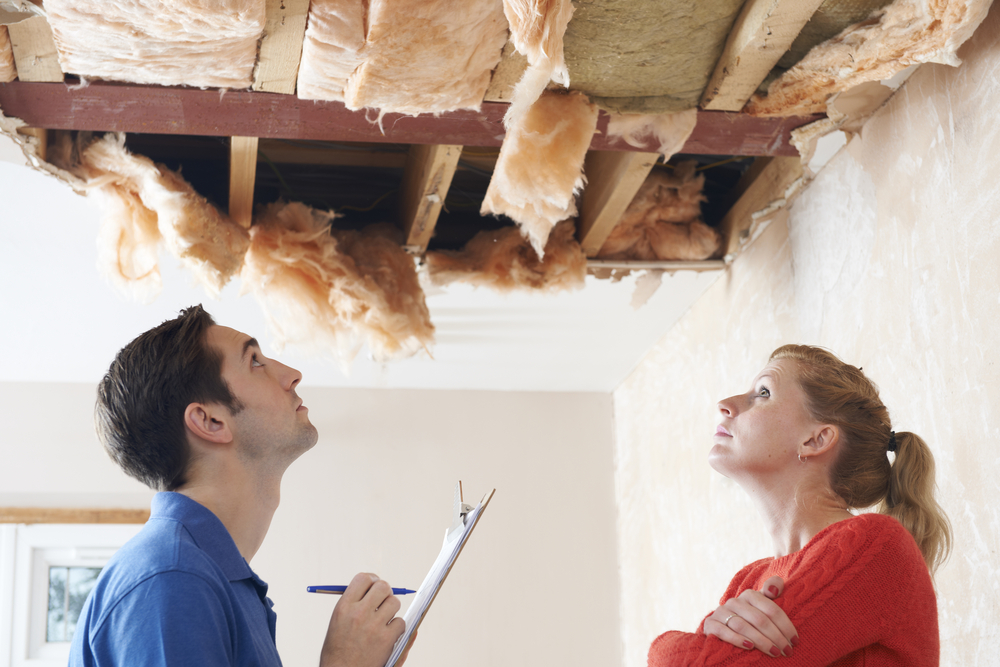When your roof is damaged, you want it repaired quickly. After all, your roof protects your home’s interior and your possessions.
To have the best chance of filing a successful homeowners’ insurance claim, you need to understand:
- What your homeowners’ insurance policy covers
- What it does not cover
- The information you will need to document your claim
- How to negotiate or file an appeal with your insurance company should that become that be necessary
- What to do to make temporary repairs to your roof until your claim is approved
The advice in this blog post will help you in your quest to file a successful claim.
Understanding Your Homeowners’ Insurance Policy
Homeowners’ insurance policies vary from company to company. Carefully read your policy before filing a roof insurance claim.
You may find that after a high wind has blown off a few shingles, your insurance company classifies it as cosmetic damage and denies the claim. On the other hand, you may find that because the damage to your roof is covered, damage to your possessions is also covered.

Policy Coverage
Although coverage varies, homeowners’ insurance policies commonly offer coverage of some items as standard.
What is commonly covered:
- Damage from hail storms
- Damage from smoke or a fire
- Damage from a lightning strike
- Damage from recent storms
- Damage from wind
- Damage from the weight of snow or ice lying on the roof
- Natural disasters such as hurricanes or tornadoes
- Damage due to roof leaks
- Damage caused by vandals
- Damage from falling objects
Your coverage depends on whether your insurance policy offers replacement cost coverage or actual cash value coverage.
Replacement Cost Coverage
if your policy provides replacement cost coverage, your company pays the full cost of repairing or replacing the covered damages with all new materials of the same kind and quality.
Some policies stipulate that the repair or replacement occur within a certain period to be eligible for replacement cost coverage. Beyond that period, your insurance company may only pay the actual cash value of the repair or replacement.
Actual Cash Value
An actual cash value payment covers the current cost of repair or replacement minus depreciation attributed to the wear and aging of the roof or other covered property. Actual cash value payments do not fully compensate you for repairing or replacing your roof and other damaged property.
Deductible
Homeowners’ policies generally have two types of deductibles that depend on the source of the damage.
If wind or hail caused the damage to your roof, then you pay the Wind/Hail Deductible. If the damage resulted from something other than wind or hail, you pay the All Other Perils (AOP) Deductible.
A common amount for the AOP Deductible is $1,000.
The Wind/Hail Deductible may also be a flat dollar amount like the AOP Deductible. However, the Wind/Hail Deductible might represent a percentage of the amount for which your home is insured, not a percentage of the total cost of the roof repairs.
If, for example, your home is insured for $500,000 and you have a 2% deductible, you must pay the first $10,000 of the repairs.
Exclusions
Just as homeowners’ insurance policies have standard types of damage that they generally cover, other potential sources of damage may be commonly excluded from coverage. The list of exclusions may include:
- Damage due to mold or mildew
- Damage caused by animals, birds, or insects
- Damage resulting from negligence, dysfunction, or lack of maintenance
- Damage due to normal wear and tear
- Damage resulting from improper installation by you or an unlicensed contractor
- Damage caused by sewer backups
- Damage from a flood, mudslide, landslide, earthquake, or sinkhole
- Damage from extreme weather that is normal to the climate in your area
- Roofs more than 20 years old
In the case of an older roof that has not yet been excluded from coverage by age, your insurance company may depreciate the repair costs because it attributes some of the damage to the wear and tear of aging.
Roofing Insurance Claim Process

Your insurance claim process should start before your roof is damaged.
Prepare Your Documentation Before Damage Occurs
You should periodically take pictures of your roof to prove that it is in good condition. If the weather forecast predicts storms for your area, take pictures of your roof before the storms arrive if you have ample time to do so safely.
You should also periodically take pictures of your home’s interior and your possessions. These photos can help you with several different types of insurance claims.
Only deal with a reputable, licensed roofing company.
Keep records of any roof maintenance, repairs, or replacements you have done. It’s a good idea to have a contract that shows you have your roof inspected annually and that any needed repairs are done promptly. You should also have documentation of the type of roofing material you have, how old it is, its warranty, and its expected lifespan.
Document the Damage to Your Roof
If your roof is damaged, take photos or a video of your roof from the ground as soon as you can do so safely. If you have a drone or a relative, friend, or neighbor has one, fly it over your roof and take photos or a video. If the interior of your home or your possessions are damaged, take photos or a video of that damage as well. If you do not have pictures of your roof before the damage occurred, you may be able to find one on Google Earth or with the loan papers from your bank.
As soon as possible, write a detailed description of the immediate damage to your home and possessions. Then, keep a detailed record of ongoing problems, safety issues, and new damage resulting from the original damage. Include issues such as leaks, areas of the roof that may have been weakened but that are not yet showing visible signs of damage, electrical problems, and the reasonable, realistic potential damage that could result from these issues.
In addition, add a detailed description of the typical weather patterns in your area for the current season and the realistic additional damage that could occur to your roof or any exposed interior areas of your home due to those weather conditions.
Unless you are permitted by your policy, do not make any repairs, including temporary ones, until you talk to your insurance company’s inspector or claims adjuster. If you receive permission to make temporary repairs but need help completing them, contact your local FEMA office for assistance from Project Blue Roof.
Your detailed descriptions and photos or videos could help prioritize your claim. Even if it is not prioritized, you may receive permission for temporary repairs.
Filing Your Roof Repair Claim
Make copies of the documentation you have created so that you can keep the originals for your records, then call your insurance company to report the damage. The insurance company will schedule an appointment for their claims adjuster or inspector to examine the damage.
Use the forms or the app provided by your company to file your claim with the adjuster, and submit your documentation with your claim.
File your paperwork promptly because some policies limit your time to file a claim after the damage occurs.
Adjuster Inspection
Specifically, the claims adjuster will look for:
- The type of roofing material
- The lifespan of the roofing material
- The quality of the roofing material
- The age of the roof
- How well the roof has been maintained
- The weather that is typical in your area
- The amount of damage done to the roof
- Normal wear and tear
- Granular loss on asphalt shingles
- Missing or cracked and curled shingles
- Exposure of the underlayment or the layer of the roofing below the shingles
- Signs of water damage below the shingles
- Dark streaks on the shingles caused by algae growth
Some insurance companies require an estimate from a roofing company before they will settle your claim.
Even if it’s not required, an estimate will help you calculate how much of a payment amount you should ask for in your claim. You should bid for the highest amount you are entitled to under the terms of your policy.
If your claim is denied, an estimate will let you know how much you will have to pay for the repair.
When choosing the roofing company to provide your estimate, it is licensed and has experience working with insurance companies. Look for a local company that will describe the damage as it appears to them in writing with a detailed written estimate of what is needed for the repair or replacement.
How to Negotiate with or Appeal to the Insurance Company

The more detailed and organized you are when you present your claim, the more successful you will be in your negotiation or appeal.
Your claim should demonstrate that you understand what damage is and is not covered by your policy. If parts of your policy seem open to interpretation, ask your insurance agent for an explanation.
Even if you have no time limit on filing, the more quickly you file, the less likely your insurance company will be able to attribute the damage to delays.
In addition to following the terms of your policy when filling out your claim form and documenting the condition of your roof and home before and after the damage, you should log all phone calls and meetings you have during a negotiation or appeal. Record the dates on which conversations occurred, the names of the people involved, the subject of the discussion, and the outcome.
File your documentation, your claim, and your log together with your household records for future reference.
Roofing Insurance FAQs
What is the average claim payout for a roof replacement?
According to Forbes, the average insurance payout for a roof replacement on an average-sized home is $11,500.
Will insurance cover an old roof?
Homeowners’ insurance policies place limits on the age of the roof that they will ensure. Some will not cover a roof that is over 20 years old because roofing materials are at or near the end of their lifespan at that point.
Insurance companies do not pay for damage due to normal wear and tear on a roof. The older a roof is, the more wear and tear may contribute to damage.
In cases where the roof is older but has not yet reached the age at which the insurance policy will no longer cover it, the insurance company depreciates the amount it will pay for damages to account for aging and wear and tear.
If you have photographs showing your roof was in good condition not long before the damage occurred and documented proof that you have had the roof inspected annually and that you paid for proper maintenance, you have the evidence you need to negotiate with your insurance company to reduce or eliminate the amount of the depreciation.
Does homeowner’s insurance cover roof leaks?
Homeowner’s insurance policies cover leaks resulting from commonly covered hazards such as falling tree branches, shingles blown away by high winds, or snow or ice laying on the roof. However, leaks from normal wear and tear or age are not covered.
Does insurance cover hail damage?
Yes, homeowners’ insurance policies cover hail damage from storms that have occurred in the immediate or recent past. However, they do not cover cumulative hall damage that has been allowed to build up over time.
What should you do after you receive a check?
UnitedPolicyholders.org advises carefully examining the front and back of the check and any paperwork with it for the words “full,” “final,” or “settlement.” If you cash or deposit a check with those words on it, the insurance company can regard it as acceptance of that check as full and final payment of your claim.
Regard such a check as a first offer that, as stated above, is likely to be far below the full value of your claim. If you accept a check designated as a full or final payment and discover more damage later, you will have lost your right to reopen the claim. you should carefully consider the financial situation you and your family are in before cashing or depositing such a check.
On the other hand, some states now require insurance companies to provide advances to their policyholders. These checks provide for living and other expenses while the claim is negotiated and settled in full.
If the check is not designated as a full or final settlement, you can cash or deposit it. However, send the insurance company an email or letter stating you have accepted it as a partial payment and are awaiting additional payments.
